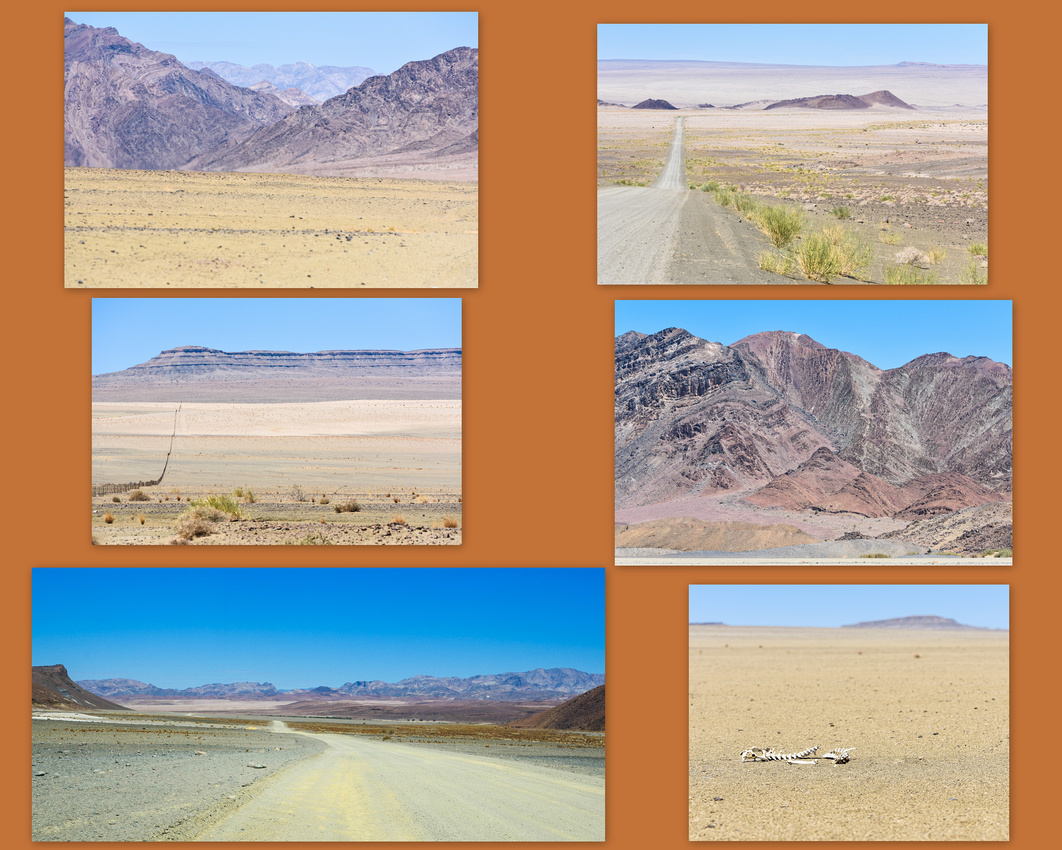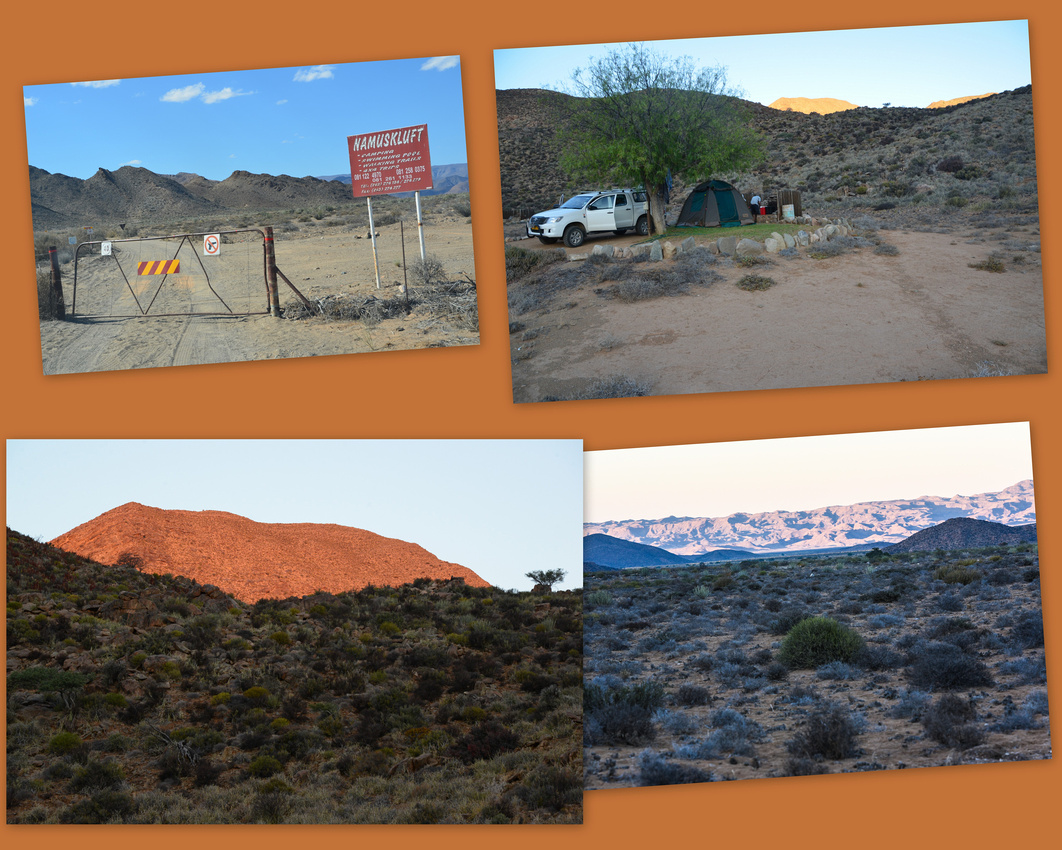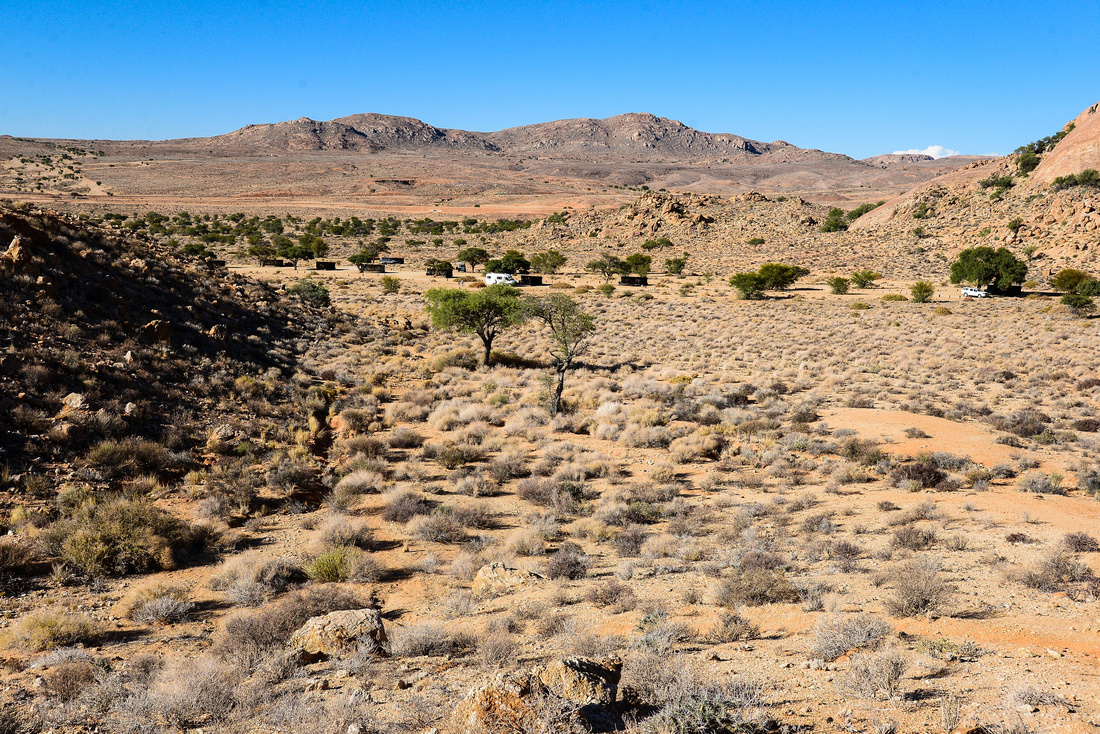Namibia - The Fish River to Klein Aus Vista, via a ghost town
I did a fair bit of four wheel driving when I was younger but still found I drove very carefully because I didn't want us to have a puncture. We had heard stories of how sharp stones had sliced into a tyre’s sidewall and I was worried about changing a tyre in soft sand in the middle of nowhere - I'll let you know how we went in later blogs😉
Our route this blog in yellow


We managed to organise linking our music to the radio so we set off early from the Canyon Roadhouse, the Mike Curb Congregation filling the cab. We found our way to the hot springs at Ai-Ais (‘burning water’ in the local language) resort winding through the Ai-Ais Huns Mountains. The springs are the end point for those hiking through the Fish River Canyon and the resort contains the eye of one of the sulphurous hot springs in the area.
We drove down the C37 through some of the most desolate magnificent country in the world toward the Orange River although I found the remains of an impala who hadn't enjoyed the scenery that much.





 We eventually saw the incongruous sight of a swathe of green hugging the surprisingly clean waters of the Orange River with South Africa’s rugged Richtersveld (Transfrontier Park) over the border. We turned right onto the C13, the Hunsberg Mountains to our right, seeing a lonely walker trudging off to nowhere - occasional quiver tree dotted the rocky slopes while a startled Klipspringer looked back before scrambling up the slope.
We eventually saw the incongruous sight of a swathe of green hugging the surprisingly clean waters of the Orange River with South Africa’s rugged Richtersveld (Transfrontier Park) over the border. We turned right onto the C13, the Hunsberg Mountains to our right, seeing a lonely walker trudging off to nowhere - occasional quiver tree dotted the rocky slopes while a startled Klipspringer looked back before scrambling up the slope.
We pass alluvial diamond workings on both sides of the river (bottom left of collage) and the river widens as we approach the border post swinging off north up the now tarred C13 leaving the water to flow to Oranjemund and the Atlantic. Dolomite ridges and dunes loom to our left and the Namusberge Mountains in the east are bathed in the afternoon sun.





 We were aiming for Namuskluft Camp site just south of Rosh Pinah and we turned off accompanied by Credence wondering who will stop the rain (they were definitely not in Namibia), bumping over corrugations until we came to the camping ground, finding that our tent could be pitched on grass (a real treat after dusty gravel surfaces). From memory site electricity is available from 6 pm until 10 pm. There was a welcome pool to cool off in (swallows dived bombed the pool as we swam)
We were aiming for Namuskluft Camp site just south of Rosh Pinah and we turned off accompanied by Credence wondering who will stop the rain (they were definitely not in Namibia), bumping over corrugations until we came to the camping ground, finding that our tent could be pitched on grass (a real treat after dusty gravel surfaces). From memory site electricity is available from 6 pm until 10 pm. There was a welcome pool to cool off in (swallows dived bombed the pool as we swam)




A touch of nostalgia for me was passing the Rosh Pinah mine site (an underground lead/zinc mine) on the way out the next morning. The mine is owned by Glencore, who bought out Xstrata that bought out Mount Isa Mines where I worked for 14 years. It was strange to see a rugby field of green plonked in the middle of the desert on the edge of town.
The C13 (still tar) from Rosh Pinah is in good condition and has many places to stop and take pictures – we could see the start of the red sands that will become the Namib dune fields further north. A mirage shimmers on the road as we approach.
After buying lamb chops in the local butcher in Aus and filling up the tanks we passed the local church stopped off at the Aus information centre on the edge of town for a toasted saamie and a chat with the girls working there, both members of the San or Bushman tribe one of thirteen tribes represented in Namibia. The San are members of various indigenous hunter-gatherer people of Southern Africa, whose territories span Botswana, Namibia, Angola, Zambia, Zimbabwe and South Africa.








We drove into the Klein Aus Vista Lodge and camping site in the early afternoon. Having told them earlier that we were coming, we were given the best campsite (10) that is apart from and looks down the slope to the other sites. Klein Aus is owned by the Gondwana Group who own the Canyon Roadhouse as well and we liked the site enough to spend four nights here, our tent pitched under an enormous sociable weaver nest. Despite there being no electricity we made do by buying ice from the lodge where you can also get wifi, a swim and frozen meat if required. Aus is 5 minutes away if you need to stock up.

 The campsite from the road below
The campsite from the road below

 The weavers never bothered us although enjoyed breakfast scraps and auditioning for a Stones song. We went for a walk one evening looking out from the escarpment as the sun set.
The weavers never bothered us although enjoyed breakfast scraps and auditioning for a Stones song. We went for a walk one evening looking out from the escarpment as the sun set.


the campsite from above our bakkie on the right



 While there we visited the famous wild Namib Desert horses drinking hole in the Garub Plains about 15 minutes outside Aus. Their provenance is unclear but the most likely ancestors of the horses are a mix of riding horses and cavalry horses, many from German breeding programs, released from various farms and camps in the early 20th century, especially during World War I. There are between 90 and 150 horses. The first visit was disappointing but on the second trip we saw many horses, oryx and ostriches milling around the waterhole with the pecking order very obvious, horses first, ostriches last! Two oryx (known as gemsbok as well) tested their neck muscles with some exercise while the ostriches look on.
While there we visited the famous wild Namib Desert horses drinking hole in the Garub Plains about 15 minutes outside Aus. Their provenance is unclear but the most likely ancestors of the horses are a mix of riding horses and cavalry horses, many from German breeding programs, released from various farms and camps in the early 20th century, especially during World War I. There are between 90 and 150 horses. The first visit was disappointing but on the second trip we saw many horses, oryx and ostriches milling around the waterhole with the pecking order very obvious, horses first, ostriches last! Two oryx (known as gemsbok as well) tested their neck muscles with some exercise while the ostriches look on.






Jerry Garcia’s melancholy steel guitar backing of Stephan Stills’ Change Partners started off our day trip to Luderitz down the B4 to the coast.
The road is magnificent, desolate and quiet, like everything in Namibia, particularly in the south. We passed what looked like abandoned railway houses It gradually got windier as we got closer to the town the sand whipping across the tar. We were warned to look out for hyenas but didn’t spot one. Brown hyenas, which prey on seal colonies around Luderitz have been killed on the road. The town is small nestled in the pale rock formations which have been described as the most inhospitable coastline in Africa. We found the spot where Diaz landed in 1488 on his return to Portugal from southern adventures.
Lüderitz hosts the Lüderitz Speed Challenge where sailors and windsurfers can reach up to 90 km/h over the 500 m course in 40 knots (74 km/h) to 50 knots (93 km/h) winds.



 We decided to visit the mining ghost town of Kolmanskop 10 mins outside Luderitz. In 1908 a local worker found a diamond in the dust in the area that became Kolmanskop. Construction of the town was overseen by a German architect and had full amenities, including a hospital, ballroom, power station, theatre, sports hall, casino, pool, bakery and the first x-ray station in the southern hemisphere. Workers were provided with daily ice rations. Kolmanskop also had the first tram in Africa, and a small railway linked it to Lüderitz.
We decided to visit the mining ghost town of Kolmanskop 10 mins outside Luderitz. In 1908 a local worker found a diamond in the dust in the area that became Kolmanskop. Construction of the town was overseen by a German architect and had full amenities, including a hospital, ballroom, power station, theatre, sports hall, casino, pool, bakery and the first x-ray station in the southern hemisphere. Workers were provided with daily ice rations. Kolmanskop also had the first tram in Africa, and a small railway linked it to Lüderitz.
The town was abandoned in 1954 when the diamonds ran out and now fights a losing battle against the wind and sand.
Any visit needs to be in a tour group and we found out, when we signed on for the tour at 10.30, that that day was Namibian Independence Day and all shops closed at 1. Tour members parked their white 4x4s (there seems to be no other kind of vehicle in the Namibian countryside) and we met in the hall for the start of our tour. Once the initial tour was complete I went one way while Jenny stayed with the tour - it was rushed as we needed to stock up at Spar before it closed but we managed to get a few pictures. All my Kolmanskop photos can be found here.










Comments
Jeff
http://www.printradiant.com | http://www.printlinkage.com | http://www.hitsticker.com | http://www.stickermac.com